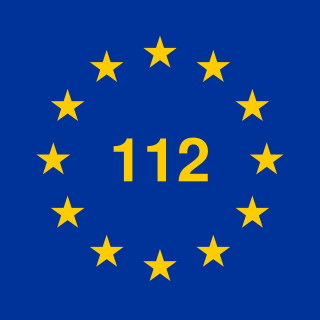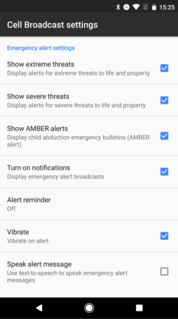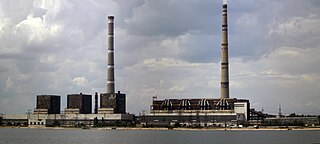Related Research Articles
Voice over Internet Protocol (VoIP), also called IP telephony, is a method and group of technologies for the delivery of voice communications and multimedia sessions over Internet Protocol (IP) networks, such as the Internet. The terms Internet telephony, broadband telephony, and broadband phone service specifically refer to the provisioning of communications services over the Internet, rather than via the public switched telephone network (PSTN), also known as plain old telephone service (POTS).

9-1-1, usually written 911, is an emergency telephone number for the United States, Canada, Palau, Argentina, Philippines, Jordan, as well as the North American Numbering Plan (NANP), one of eight N11 codes. Like other emergency numbers around the world, this number is intended for use in emergency circumstances only. Using it for any other purpose is a crime in most jurisdictions.
Enhanced 911, E-911 or E911 is a system used in North America to automatically provide the caller's location to 911 dispatchers. 911 is the universal emergency telephone number in the region. In the European Union, a similar system exists known as E112 and known as eCall when called by a vehicle.

Most public switched telephone networks have a single emergency telephone number that allows a caller to contact local emergency services for assistance. The emergency number differs from country to country; it is typically a three-digit number so that it can be easily remembered and dialed quickly. Some countries have a different emergency number for each of the different emergency services; these often differ only by the last digit.

A pager is a wireless telecommunications device that receives and displays alphanumeric or voice messages. One-way pagers can only receive messages, while response pagers and two-way pagers can also acknowledge, reply to and originate messages using an internal transmitter.
The annual Simulated Emergency Test (SET) is a training exercise involving the Amateur Radio Emergency Service (ARES) and the National Traffic System (NTS), a message-handling service of amateur radio. The American Radio Relay League is a prime mover in this event, which is organized somewhat like a contest. Its primary purposes are to evaluate strengths and weaknesses in emergency preparedness and communications, and to demonstrate amateur radio to the public.
University Health Network (UHN) is a public research and teaching hospital network in Toronto, Ontario, Canada. It is the largest health research organization in Canada and ranks first in Canada for total research funding. It was named Canada's top research hospital by Research Infosource from 2015 to 2021. The network includes three acute care hospitals – Toronto General Hospital, Toronto Western Hospital, Princess Margaret Cancer Centre – the Toronto Rehabilitation Institute, and The Michener Institute, a post-secondary institution granting diplomas and certificates in health sciences and leadership. In the 2019-2020 fiscal year, there were over 39,000 acute inpatient stays and close to 121,000 emergency department visits across the three acute care hospitals.
The Salvation Army Team Emergency Radio Network (SATERN) is a network of volunteer amateur radio operators that provide emergency communications between Salvation Army posts, and pass messages with health and welfare information between the Salvation Army and the general public.

112 is a common emergency telephone number that can be dialed free of charge from most mobile telephones, and in some countries, fixed telephones in order to reach emergency services.

Gustavo Rojas Pinilla International Airport is the main airport in the archipelago of San Andrés, Providencia and Santa Catalina, one of the departments of Colombia. It is able to receive large aircraft and to accommodate seasonal and charter flights from different parts of the Americas and Europe.

In times of crisis and natural disasters, amateur radio is often used as a means of emergency communication when wireline, cell phones and other conventional means of communications fail.
Airwave Solutions Ltd. is a British mobile communication company that operates the Airwave network, a mobile communications network used by Great Britain's emergency services. The Airwave network is based on the specialist Terrestrial Trunked Radio (TETRA) specification. Airwave was acquired by Motorola Solutions in February 2016 and now operates as a wholly owned subsidiary.
Special Telecommunication Service is the Romanian institution that coordinates the activities in the field of special secure communications. STS is an agency with military status.

Cell Broadcast (CB) is a method of sending messages to multiple mobile telephone users in a defined area at the same time. It is defined by the ETSI’s GSM committee and 3GPP and is part of the 2G, 3G, 4G LTE (telecommunication) and 5G standards. It is also known as Short Message Service-Cell Broadcast (SMS-CB) or CB SMS.
Blackwater Airport is an airport in Blackwater, Queensland, Australia.
Lithuania uses an open telephone numbering plan with all phone numbers having nine digits, including the prefix "8", a 1-3 digit area code and 5-7 digit subscriber telephone number. The current plan was introduced in stages in 2001-2003, replacing Soviet-legacy area codes and altering some subscriber numbers.

Vuhlehirska power station is a coal-fueled thermal power station located in Svitlodarsk, Ukraine. It consists of 7 units with a total power output of 3,600 MW and was put in service between 1972 and 1977. Vuhlehirska power station has a 320 metres (1,050 ft) tall flue gas stack, which is one of the tallest structures in Ukraine. Since August 1995 the power station is operated by Centrenergo.
9-1-1, commonly referred to as 911, is the national emergency telephone number of the Philippines managed by the Emergency 911 National Office.
The Minimum Essential Emergency Communications Network (MEECN) is a network of systems providing uninterrupted communications throughout the pre-, trans-, and post-nuclear warfare environment. At minimum, MEECN is designed to provide a one-way flow of information to activate nuclear forces during severe jamming and a post-nuclear environment.
References
- 1 2 3 4 "Emergency Services Network: overview". GOV.UK. 14 April 2022. Archived from the original on 2022-07-28. Retrieved 2022-07-28.
- 1 2 3 Clark, Lindsay (9 June 2022). "UK police to spend tens of millions on legacy comms network kit". The Register. Retrieved 9 June 2022.
- 1 2 "Emergency services network". gov.uk . 14 December 2015. Archived from the original on 29 January 2017. Retrieved 28 December 2018.
- ↑ "Emergency network plans questioned". BBC News . 10 June 2015. Retrieved 28 December 2018.
- ↑ Penning, Mike (27 August 2015). "First contract for new emergency services network awarded". gov.uk . Retrieved 28 December 2018.
- ↑ "Emergency services' radio replacement delays 'could cost millions'". BBC News . 25 January 2017. Retrieved 28 December 2018.
- ↑ "Motorola Solutions Reaches Agreement with UK Home Office to Implement ESN Phased Approach and Extend Airwave Network". Motorola Solutions . 21 September 2018. Retrieved 28 December 2018.
- ↑ "Huawei's kit removed from emergency services 4G network". BBC News . 24 December 2018. Retrieved 28 December 2018.
- ↑ "ESN exclusive: in sight of the finishing line". Critical Communications Today. Retrieved 2022-07-28.